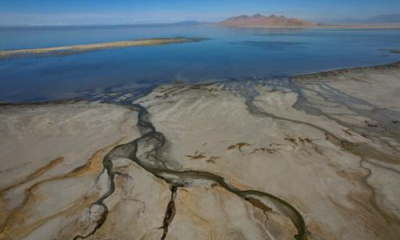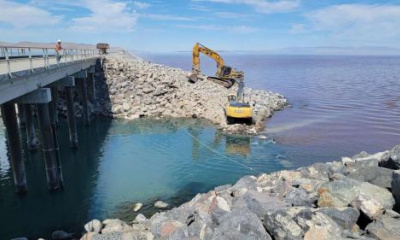Utah’s record-setting winter has been exciting for both skiers and lawmakers working to revive the ailing Great Salt Lake. Gov. Spencer Cox told reporters in mid-March that lake levels were up 2 feet and they were hopeful for 5 feet more. There was also the good news that the Church of Jesus Christ of Latter-day Saints had donated 20,000 acre-feet of water to the lake.
The optimism contrasts with a Brigham Young University study from earlier in the year that indicates the lake could vanish in roughly five years if aggressive action isn’t taken to preserve it. For his part, the governor is bullish on what lawmakers have done for the lake and wishes scientists would ease up on the “doom and gloom.”
So, how will we know when the Great Salt Lake turns a corner? Here are a few of the key indicators of recovery that scientists and state officials will look for:
Water levels
The amount of water flowing into and staying in Great Salt Lake is the most critical sign of its recovery. With the amount of snow and rain Utah has received this winter, the lake’s current levels are at about 4,190 feet — above the record low hit last November — and that’s before the spring runoff.
Candice Hasenyager, the director of the Utah Division of Water Resources, said it’s already an improvement.
“Last year, over the whole runoff season, it only rose about a foot. And the year before it was less than a foot,” she said. “So the fact that we are pretty run up and have already risen 2 feet is great news.”
But the lake is still not at a healthy water level. It would need to go up another 8 feet to escape the danger zone.
All of this water only “buys us a little time,” said Bonnie Baxter, the director of the Great Salt Lake Institute. As summertime arrives “we need to be really cautious.”
Baxter also noted the lake dropped by about 3 feet every summer for the last three years.
She believes a positive sign the lake is recovering can be found in surrounding areas, like Farmington Bay and Antelope Island.
Ben Stireman, the sovereign lands program administrator for the Utah Division of Forestry, Fire and State Lands, said higher water levels in those areas “is a good sign” because “it’s either direct precipitation [on] the lake bed or inflows from the main tributaries.”
But Baxter doesn’t want the public to believe all the rain and snow has lifted Utah out of a megadrought or that the lake is now OK and revert back to their water-wasting habits.
“We just need to keep moving as if we didn't get all this water.”
Salinity levels
As the name implies, Great Salt Lake is naturally salty. But too much salt can harm the diverse ecosystem that calls the iconic lake home.
Hasenyager said salinity levels are a big concern, especially during drought years. Since it is a terminal lake, meaning there is no outlet for the water to flow elsewhere, the only exit from the lake is by evaporation. But only fresh water evaporates and the salt stays behind.
So, in order to stabilize salinity levels, water needs to make its way into the lake.
“That's why we've had declining inflows the last couple of years and the increased evaporation because of the temperature through the lake, the south arm got saltier,” she said.
Right now the salinity is at roughly 160 grams per liter or about 16%, which Hasenyager said is “just barely back into the ideal range of the salinity for the south arm.”
The ideal range is between 120 to 160 grams per liter. Salinity is a huge factor for Baxter as well. She would like to see levels between 15% and 17% in the summer when the majority of evaporation occurs.
“We ended at 19% salt last year, which was terrible. And all of the biology was really struggling.”
The biology
Baxter will be “monitoring the recovery” of mats on the microbialites on the bottom of the lake. Microbialites are rock-like formations that look like reefs but are actually composed of millions of little microbe organisms.
“That's where the brine flies pupate and the mats have just been disappearing because they can't sustain themselves in that salinity that's that high.”
Another sign of lake health of the lake is the lifespan of brine flies. She said there were little to no brine flies buzzing around last August, which is a bad sign. Brine flies and shrimp are what feed all the migratory birds that visit the lake.
The Utah Legislature passed a handful of laws this year related to water conservation, including $200 million in agriculture optimization to help farmers update infrastructure. Lawmakers also allocated more money to a turf buyback program to encourage homeowners to replace their thirsty lawns.
“Even though we had a great year, this is not the time to take our foot off the gas pedal,” Hasenyager said. “We still need to reduce how much water we're using.”









